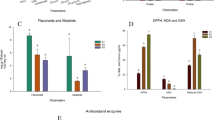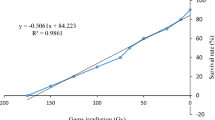Abstract
Aluminum (Al) is one of the most important stress factors that reduce plant productivity in acidic soils. Present work thereby analyzed Al-induced genomic alterations in Bryophyllum daigremontianum clones using RAPD and ISSR markers, and investigated responding changes in photosynthetic pigment (chlorophyll a, b, a/b, total chlorophyll and carotenoid) contents and total soluble protein amounts in plant leaves. The main reason for the use of bulbiferous spurs originated clone plants was to increase reliability and acceptability of RAPD and ISSR techniques in DNA fingerprinting. Raised 40 clone plants were divided into five separate groups each with eight individuals and each experimental group was watered with 0 (control), 0 (acid control), 50, 100 and 200 µM AlCl3-containing Hoagland solutions on alternate days for two and a half months. All plant soils except control group were sprayed with 0.2% sulfuric acid following watering days and this contributed acidic characteristic (pH 4.8) to soil structure. Increase in Al concentrations were accompanied by an increase in total soluble protein amounts, a decrease in photosynthetic pigment contents, and with appearance, disappearance and intensity changes at RAPD and ISSR band profiles. Out of tested RAPD1-25 and ISSR1-15 primers, RAPD8, RAPD9, ISSR2 and ISSR7 primers produced reproducible band profiles that were distinguishable between treatment and control groups. Findings showed that RAPD and ISSR fingerprints have been useful biomarkers for investigation of plant genotoxicity, especially in clone plants. Moreover, if these fingerprints are integrated with other physiological parameters they could become more powerful tools in ecotoxicology.



Similar content being viewed by others
References
Dogan I, Ozyigit II, Demir G (2014) Influence of aluminum on mineral nutrient uptake and accumulation in Urtica pilulifera L. J Plant Nutr 37:469–481
Zahedi-Amiri Z, Taravati A, Hejazian LB (2018) Protective effect of Rosa damascena against aluminum chloride-induced oxidative stress. Biol Trace Elem Res 187:1–8
Vardar F, Cabuk E, Ayturk O, Aydin Y (2016) Determination of aluminum induced programmed cell death characterized by DNA fragmentation in Gramineae species. Caryologia 69(2):111–115
Drabek O, Mladkova L, Boruvka L, Szakova J, Nikodem A, Nemecek K (2005) Comparison of water-soluble and exchangeable forms of Al in acid forest soils. J Inorg Biochem 99:1788–1795
Kochian LV, Pineros MA, Hoekenga OA (2005) The physiology, genetics and molecular biology of plant aluminum resistance and toxicity. Plant Soil 274:175–195
Kochian LV (1995) Cellular mechanisms of aluminum toxicity and resistance in plants. Ann Rev Plant Physiol 46:237–260
Rengel Z (2004) Aluminium cycling in the soil-plant-animal-human continuum. Biometals 17:669–689
Vardar F, Unal M (2007) Aluminum toxicity and resistance in higher plants, review. Adv Mol Bio 1:1–12
Navascues J, Pérez-Rontomé C, Sánchez DH, Staudinger C, Wienkoop S, Rellán-Álvarez R, Becana M (2012) Oxidative stress is a consequence, not a cause, of aluminum toxicity in the forage legume Lotus corniculatus. New Phytol 193(3):625–636
Chen LS, Qi YP, Liu XH (2005) Effects of aluminum on light energy utilization and photoprotective systems in citrus leaves. Ann Bot-London 96(1):35–41
Dong B, Sang WL, Jiang X, Zhou JM, Kong FX, Hu W, Wang LS (2002) Effects of aluminum on physiological metabolism and antioxidant system of wheat (Triticum aestivum L.). Chemosphere 47(1):87–92
Horst WJ, Wang YX, Eticha D (2010) The role of the root apoplast in aluminium-induced inhibition of root elongation and in aluminium resistance of plants: a review. Ann Bot-London 106:185–197
Yamamoto Y, Kobayashi Y, Matsumoto H (2001) Lipid peroxidation is an early symptom triggered by aluminum, but not the primary cause of elongation inhibition in pea roots. Plant Physiol 125(1):199–208
Maron LG, Kirst M, Mao C, Milner MJ, Menossi M, Kochian LV (2008) Transcriptional profiling of aluminum toxicity and tolerance responses in maize roots. New Phytol 179:116–128
Panda SK, Matsumoto H (2010) Changes in antioxidant gene expression and induction of oxidative stress in pea (Pisum sativum L.) under Al stress. Biometals 23(4):753–762
Matsumoto H (2000) Cell biology of aluminum toxicity and tolerance in higher plants. Int Rev Cytol 200:1–46
Panda SK, Yamamoto Y, Kondo H, Matsumoto H (2008) Mitochondrial alterations related to programmed cell death in tobacco cells under aluminium stress. C R Biol 331:597–610
Yamamoto Y, Kobayashi Y, Devi SR, Rikishi S, Matsumoto H (2002) Aluminium toxicity is associated with mitochondrial dysfunction and the production of reactive oxygen species in plant cells. Plant Physiol 128:63–72
Pour AH, Ozkan G, Balpinar Nalci O, Haliloglu K (2019) Estimation of genomic instability and DNA methylation due to aluminum (Al) stress in wheat (Triticum aestivum L.) using iPBS and CRED-iPBS analyses. Turk J Bot 43(1):27–37
Von Uexkull HR, Mutert HR (1995) Global extent, development and economic impact of acid soils. Plant Soil 171(1):1–15
Ozyigit II, Vardar F, Yasar U, Akinci S (2013) Long time effects of aluminum and cadmium on growth, leaf anatomy, and photosynthetic pigments of cotton. Commun Soil Sci Plant Anal 44:3076–3091
Hoagland DR, Arnon DI (1950) The water-culture method for growing plants without soil. Circ Calif Agric Exp Stn 347(2nd edit):32
Arnon DI (1949) Copper enzymes in isolated chloroplasts. Polyphenoloxidase in Beta vulgaris. Plant Physiol 24(1):1–15
Bradford M (1976) A rapid and sensitive method for the quantitation of microgram quantities of protein utilizing the principle of protein-dye binding. Anal Biochem 72(1–2):248–254
Qiu YX, Hong DY, Fu CX, Cameron KM (2004) Genetic variation in the endangered and endemic species Changium smyrnioides (Apiaceae). Biochem Syst Ecol 32:583–596
Zhang H, Li YH, Hu LY, Wang SH, Zhang FQ, Hu KD (2008) Effects of exogenous nitric oxide donor on antioxidant metabolism in wheat leaves under aluminum stress. Russ J Plant Physl 55(4):469–474
Ozyigit II, Yilmaz S, Dogan I, Sakcali MS, Tombuloglu G, Demir G (2016) Detection of physiological and genotoxic damages reflecting toxicity in kalanchoe clones. Global NEST J 18(1):223–232
Mihailovic I, Drazic G, Vucinic GZ (2006) Effects of aluminium on photosynthetic performance in Al-sensitive and Al-tolerant maize inbred lines. Photosynthetica 46:476–480
Wang L, Fan XW, Pan JL, Huang ZB, Li YZ (2015) Physiological characterization of maize tolerance to low dose of aluminum, highlighted by promoted leaf growth. Planta 242(6):1391–1403
Barnabas B, Kovacs G, Hegedus A, Erdei S, Horvath G (2000) Regeneration of doubled haploid plants from in vitro selected microspores to improve aluminium tolerance in wheat. J Plant Physiol 156(2):217–222
Tabaldi LA, Nicoloso FT, Castro GY, Cargnelutti D, Gonçalves JF, Rauber R, Skrebensky EC, Schetinger MRC, Morsch VM, Bisognin DA (2007) Physiological and oxidative stress responses of four potato clones to aluminum in nutrient solution. Braz J Plant Physiol 19(3):211–222
Azmat R, Hasan S (2008) Photochemistry of light harvesting pigments and some biochemical changes under aluminium stress. Pak J Bot 40(2):779–784
Wang Vinocur WB, Shoseyov O, Altman A (2004) Role of plant heat shock proteins and molecular chaperones in the abiotic stress response. Trends Plant Sci 9:244–252
Vinocur B, Altman A (2005) Recent advances in engineering plant tolerance to abiotic stress: achievements and limitation. Curr Opin Biotech 16:123–132
Kosakivska I, Klymchuk D, Negretzky V, Bluma D, Ustinova A (2008) Stress proteins and ultrastructural characteristics of leaf cells of plants with different types of ecologıcal strategies. Gen Appl Plant Physiol 34(3–4):405–418
Murillo-Amador B, Cordoba-Matson MV, Villegas-Espinoza JA, Herna´ndez-Montiel LG, Troyo-Die´guez E (2014) Mineral content and biochemical variables of Aloe vera L. under salt stress. PLoS ONE 9(4):e94870
Salinas C, Handford M, Pauly M, Dupree P, Cardemil L (2016) Structural modifications of fructans in Aloe barbadensis Miller (Aloe vera) grown under water stress. PLoS ONE 11(7):e0159819
Karimi F, Khataee E (2012) Aluminum elicits tropane alkaloid production and antioxidant system activity in micropropagated Datura innoxia plantlets. Acta Physiol Plant 34(3):1035–1041
Zafar N, Mujib A, Ali M, Tonk D, Gulzar B (2017) Aluminum chloride elicitation (amendment) improves callus biomass growth and reserpine yield in Rauvolfia serpentina leaf callus. Plant Cell Tissue Org 130(2):357–368
Rastgoo L, Alemzadeh A (2011) Biochemical responses of gouan (‘Aeluropus littoralis’) to heavy metals stress. Aust J Crop Sci 5(4):375–383
Zahid HS, Mujib A (2012) Accumulation of vincristine in calcium chloride elicitated Catharanthus roseus cultures. Nat Prod J 2(4):307–315
Malar S, Manikandan R, Favas PJ, Sahi SV, Venkatachalam P (2014) Effect of lead on phytotoxicity, growth, biochemical alterations and its role on genomic template stability in Sesbania grandiflora: a potential plant for phytoremediation. Ecotox Environ Safe 108:249–257
Shahrtash M, Mohsenzadeh S, Mohabatkar H (2010) Cadmium-induced genotoxicity detected by the random amplification of polymorphism DNA in the maize seedling roots. J Cell Mol Res 2(1):42–48
Ozyigit II, Dogan I, Igdelioglu S, Filiz E, Karadeniz S, Uzunova Z (2016) Screening of damage induced by lead (Pb) in rye (Secale cereale L.)-a genetic and physiological approach. Biotechnol Biotechnol Equip 30(3):489–496
Cenkci S, Yildiz M, Cigerci IH, Konuk M, Bozdag A (2009) Toxic chemicals-induced genotoxicity detected by random amplified polymorphic DNA (RAPD) in bean (Phaseolus vulgaris L.) seedlings. Chemosphere 76(7):900–906
Kekec G, Sakcali MS, Uzonur I (2010) Assessment of genotoxic effects of Boron on Wheat (Triticum aestivum L.) and Bean (Phaseolus vulgaris L.) using RAPD analysis. Bull Environ Contam Tox 84(6):759–764
Taspinar MS, Aydin M, Sigmaz B, Yagci S, Arslan E, Agar G (2018) Aluminum-induced changes on DNA damage, DNA methylation and LTR retrotransposon polymorphism in maize. Arab J Sci Eng 43(1):123–131
Correia S, Matos M, Ferreira V, Martins N, Goncalves S, Romano A, Pinto-Carnide O (2014) Molecular instability induced by aluminum stress in Plantago species. Mutat Res-Gen Toxicol Environ Mutat 770:105–111
Bojorquez-Quintal JEA, Sánchez-Cach LA, Ku-González A, Santos-Briones C, Medina-Lara MF, Echevarría-Machado I, Muñoz-Sánchez JA, Sotomayor SMTH, Estévez MM (2014) Differential effects of aluminum on in vitro primary root growth, nutrient content and phospholipase C activity in coffee seedlings (Coffea arabica). J Inorg Biochem 134:39–48
Silva IR, Smyth TJ, Moxley DF, Carter TE, Allen NS, Rufty TW (2000) Aluminum accumulation at nuclei of cells in the root tip. Fluorescence detection using lumogallion and confocal laser scanning microscopy. Plant Physiol 123(2):543–552
Li Z, Xing D (2011) Mechanistic study of mitochondria dependent programmed cell death induced by aluminum phytotoxicity using fluorescence techniques. J Exp Bot 62(1):331–343
Atienzar FA, Cordi B, Evenden AJ (1999) Qualitative assessment of genotoxicity using random amplified polymorphic DNA: comparison of genomic template stability with key fitness parameters in Daphnia magna exposed to benzo [a] pyrene. Environ Toxicol Chem 18:2275–2282
Bowditch BM, Albright DG, Williams JGK, Braun MJ (1993) Use of randomly amplified polymorphic DNA markers in comparative genome studies. Methods Enzymol 224:293–309
Pan J, Yu L (2011) Effects of Cd or/and Pb on soil enzyme activities and microbial community structure. Ecol Eng 37(11):1889–1894
Atienzar FA, Venier P, Jha AN, Depledge MH (2002) Evaluation of the random amplified polymorphic DNA (RAPD) assay for the detection of DNA damage and mutations. Mutat Res-Gen Toxicol Environ Mutat 521(1):151–163
Atienzar FA, Cordi B, Donkin ME (2000) Comparison of 442 ultraviolet- induced genotoxicity detected by random amplified polymorphic DNA with chlorophyll fluorescence and growth in a marine macroalgae. Aquat Toxicol 50:1–12
Korpe DA, Aras S (2011) Evaluation of copper-induced stress on eggplant (Solanum melongena L.) seedlings at the molecular and population levels by use of various biomarkers. Mutat Res-Gen Toxicol Environ Mutat 719(1):29–34
Acknowledgements
This project is supported by Düzce University Research Fund. Project Number: 2015.05.01.376.
Author information
Authors and Affiliations
Corresponding author
Ethics declarations
Conflict of interest
No potential conflict of interest was reported by the authors.
Additional information
Publisher’s Note
Springer Nature remains neutral with regard to jurisdictional claims in published maps and institutional affiliations.
Rights and permissions
About this article
Cite this article
Ozyigit, I.I., Kaval, A., Altundag Cakir, E. et al. DNA fingerprinting and assessment of some physiological changes in Al-induced Bryophyllum daigremontianum clones. Mol Biol Rep 46, 2703–2711 (2019). https://doi.org/10.1007/s11033-019-04714-w
Received:
Accepted:
Published:
Issue Date:
DOI: https://doi.org/10.1007/s11033-019-04714-w




